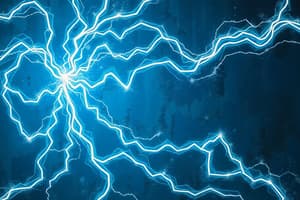Podcast
Questions and Answers
Frequency is expressed as cycles per second, or Hertz (Hz).
Frequency is expressed as cycles per second, or Hertz (Hz).
True (A)
For current to flow through a circuit, the power source must apply enough electromotive force (voltage) to cause electrons to flow.
For current to flow through a circuit, the power source must apply enough electromotive force (voltage) to cause electrons to flow.
True (A)
Current flow in an alternating-current circuit moves in both directions due to the changing polarity of the voltage, whereas direct current flows only in one direction.
Current flow in an alternating-current circuit moves in both directions due to the changing polarity of the voltage, whereas direct current flows only in one direction.
True (A)
When a magnetic field moves through a coil of wire, the lines of force of the magnetic field cause electrons in the wire to flow in a specific direction.
When a magnetic field moves through a coil of wire, the lines of force of the magnetic field cause electrons in the wire to flow in a specific direction.
A simple ac generator can be visualized as a loop of wire rotating within the magnetic lines of force between similar poles of a magnet.
A simple ac generator can be visualized as a loop of wire rotating within the magnetic lines of force between similar poles of a magnet.
The voltage produced by an ac generator is dependent upon the _____.
The voltage produced by an ac generator is dependent upon the _____.
A waveform is a mathematical representation on a graph that can be used to visualize the level and direction of _____ in a circuit.
A waveform is a mathematical representation on a graph that can be used to visualize the level and direction of _____ in a circuit.
A pure direct-current waveform displays the polarity and magnitude of the current or voltage as a flat waveform.
A pure direct-current waveform displays the polarity and magnitude of the current or voltage as a flat waveform.
Most commercial alternating-current power is produced by a generator driven by _____.
Most commercial alternating-current power is produced by a generator driven by _____.
The waveform for alternating-current circuits is symmetrical with positive above and negative below the zero-reference level.
The waveform for alternating-current circuits is symmetrical with positive above and negative below the zero-reference level.
A nonsinusoidal (or nonsymmetrical) waveform is produced when multiple alternating-current waveforms of different frequencies are introduced on a circuit, typically by _____.
A nonsinusoidal (or nonsymmetrical) waveform is produced when multiple alternating-current waveforms of different frequencies are introduced on a circuit, typically by _____.
When the term "_____" is used in relation to waveforms, it indicates the degree relationship between two waveforms, such as voltage-to-current or voltage-to-voltage.
When the term "_____" is used in relation to waveforms, it indicates the degree relationship between two waveforms, such as voltage-to-current or voltage-to-voltage.
Waveforms that are "in-phase" with each other means that at every instant, the current is exactly in step with the applied voltage, and both the current and voltage waveforms reach their zero and peak values at the same instant in time.
Waveforms that are "in-phase" with each other means that at every instant, the current is exactly in step with the applied voltage, and both the current and voltage waveforms reach their zero and peak values at the same instant in time.
A three-phase generator has each of its three windings evenly spaced around the rotor and the windings are 120° out-of-phase from each other.
A three-phase generator has each of its three windings evenly spaced around the rotor and the windings are 120° out-of-phase from each other.
When describing the relationship between voltage and current waveforms, the reference waveform (the one used to compare against) is the _____.
When describing the relationship between voltage and current waveforms, the reference waveform (the one used to compare against) is the _____.
A "lagging" waveform is when the voltage lags behind the current and a "leading" waveform means the voltage leads the current.
A "lagging" waveform is when the voltage lags behind the current and a "leading" waveform means the voltage leads the current.
A _____ load has its voltage waveform finishing its cycle at the same time (without lead or lag) as the current waveform.
A _____ load has its voltage waveform finishing its cycle at the same time (without lead or lag) as the current waveform.
In circuits with _____ loads, the voltage waveform finishes its cycle before the current waveform, so the voltage waveform "leads" the current waveform.
In circuits with _____ loads, the voltage waveform finishes its cycle before the current waveform, so the voltage waveform "leads" the current waveform.
In circuits with _____ loads, the voltage waveform finishes after the current waveform so the voltage "lags" the current.
In circuits with _____ loads, the voltage waveform finishes after the current waveform so the voltage "lags" the current.
Effective current value is also known as the "Root-Mean-Square" (RMS) value.
Effective current value is also known as the "Root-Mean-Square" (RMS) value.
Depending on the instant selected, the instantaneous value can range anywhere from a zero, to a positive peak, or to a negative peak.
Depending on the instant selected, the instantaneous value can range anywhere from a zero, to a positive peak, or to a negative peak.
The peak value of a waveform is the maximum value the current or voltage waveform reaches during each full cycle of the rotation of the generator's rotor.
The peak value of a waveform is the maximum value the current or voltage waveform reaches during each full cycle of the rotation of the generator's rotor.
The effective value of ac voltage or ac current is the equivalent value of dc voltage or dc current that would produce the same amount of heat in a resistor.
The effective value of ac voltage or ac current is the equivalent value of dc voltage or dc current that would produce the same amount of heat in a resistor.
For alternating current, the effective value can be determined by using which of the following formulas?
For alternating current, the effective value can be determined by using which of the following formulas?
Root-Mean-Square (RMS) describes the calculation steps (in reverse) necessary to determine the effective ac voltage or ac current value of a waveform.
Root-Mean-Square (RMS) describes the calculation steps (in reverse) necessary to determine the effective ac voltage or ac current value of a waveform.
"_____" is the ability of a device to store electrical energy and to release that energy.
"_____" is the ability of a device to store electrical energy and to release that energy.
Capacitance is measured in units of _____.
Capacitance is measured in units of _____.
When alternating current is applied to a capacitor, the current continuously moves back and forth charging and discharging the capacitor.
When alternating current is applied to a capacitor, the current continuously moves back and forth charging and discharging the capacitor.
When a _____ has reached its maximum potential difference between its metal plates, it's said to be "charged."
When a _____ has reached its maximum potential difference between its metal plates, it's said to be "charged."
If a capacitor becomes overcharged, the electrons from the negative metal plate can be pulled through the insulation (dielectric) to the positive metal plate by an excessive electric field.
If a capacitor becomes overcharged, the electrons from the negative metal plate can be pulled through the insulation (dielectric) to the positive metal plate by an excessive electric field.
To discharge a capacitor, a _____ path is required between its positive (+) and negative (-) plates.
To discharge a capacitor, a _____ path is required between its positive (+) and negative (-) plates.
The _____ the metal plates is(are) factor(s) in determining capacitance.
The _____ the metal plates is(are) factor(s) in determining capacitance.
Capacitors are often used to smooth out pulsating direct-current waveforms when ac is rectified to dc.
Capacitors are often used to smooth out pulsating direct-current waveforms when ac is rectified to dc.
Another use for a capacitor is starting single-phase motors.
Another use for a capacitor is starting single-phase motors.
Capacitors are also used to store arc producing energy spikes caused by circuit inductance when switch or relay contacts open under load.
Capacitors are also used to store arc producing energy spikes caused by circuit inductance when switch or relay contacts open under load.
Flashcards
Frequency (Hz)
Frequency (Hz)
Cycles per second; unit of measurement for AC electricity.
Electromotive Force (Voltage)
Electromotive Force (Voltage)
Force needed to push current through a circuit.
Alternating Current (AC)
Alternating Current (AC)
Current that flows in two directions due to changing polarity.
Direct Current (DC)
Direct Current (DC)
Signup and view all the flashcards
AC Generator
AC Generator
Signup and view all the flashcards
Waveform
Waveform
Signup and view all the flashcards
Phase
Phase
Signup and view all the flashcards
In-Phase Waveforms
In-Phase Waveforms
Signup and view all the flashcards
Lagging Waveform
Lagging Waveform
Signup and view all the flashcards
Leading Waveform
Leading Waveform
Signup and view all the flashcards
Resistive Loads
Resistive Loads
Signup and view all the flashcards
Inductive Loads
Inductive Loads
Signup and view all the flashcards
Capacitive Loads
Capacitive Loads
Signup and view all the flashcards
Capacitor
Capacitor
Signup and view all the flashcards
Self-Induced Voltage
Self-Induced Voltage
Signup and view all the flashcards
Resistance
Resistance
Signup and view all the flashcards
Eddy Currents
Eddy Currents
Signup and view all the flashcards
Power (Watts)
Power (Watts)
Signup and view all the flashcards
Watt's Law
Watt's Law
Signup and view all the flashcards
Power Factor
Power Factor
Signup and view all the flashcards
Efficiency
Efficiency
Signup and view all the flashcards
Study Notes
Frequency and Current Flow
- Frequency, measured in Hertz (Hz), indicates cycles per second.
- Current requires sufficient electromotive force (voltage) to flow through a circuit.
- In alternating current (AC) circuits, current flows bidirectionally due to voltage polarity changes, unlike direct current (DC) which flows unidirectionally.
Electromagnetic Phenomena
- Moving magnetic fields through a wire coil induces electron flow in the wire; direction depends on the magnetic field's movement.
- AC generators convert mechanical energy into electrical energy, influenced by the number of wire turns, magnetic field strength, and coil rotation speed.
Waveforms in Electrical Circuits
- Waveforms graphically represent current or voltage, illustrating their levels and directions.
- A pure DC waveform appears flat, representing constant voltage or current.
Power Generation and Waveform Characteristics
- Most AC power is generated using wind, steam, or water.
- AC waveforms are symmetrical about a zero-reference, alternating between positive and negative values.
Phase Relationships
- Phase describes the relational timing of two waveforms, indicating how they sync with one another.
- "In-phase" waveforms have current and voltage reaching peak values simultaneously.
- A three-phase generator features windings spaced evenly at 120° out-of-phase.
Waveform Types
- Lagging waveforms (voltage lags current) and leading waveforms (voltage leads current) indicate the relationship between voltage and current in reactive circuits.
- Resistive loads have waveforms that finish their cycles together, while inductive loads cause voltage to lead current and capacitive loads result in voltage lagging behind current.
Capacitors and Their Functions
- Capacitance stores and releases electrical energy, measured in farads.
- Capacitors charge by allowing current to flow back and forth when AC is applied and are used to smooth pulsating DC from rectified AC.
- Overcharging can cause current to transfer between capacitor plates via its dielectric insulation.
Induction and Electromagnetism
- Self-induced voltage arises from a wire's own electromagnetic field adjustments.
- Resistance in a wire is directly proportional to its length and inversely proportional to its cross-sectional area; greater diameter leads to lower resistance.
- Eddy currents result from self-induction within a wire.
Power and Efficiency
- Power is the energy transfer rate in an electric circuit, measured in watts.
- Watt's Law demonstrates the power relationship: Power = Current x Voltage.
- For parallel circuits, total power equals the sum of individual branch powers.
- Power factor indicates how aligned current is with voltage, with unity (100%) in purely resistive loads.
- Efficiency compares useful output power to input power, expressed as a ratio.
Conclusion
- Understanding frequency, AC/DC characteristics, waveform relationships, and electrical components like capacitors are essential in electrical theory and applications.
Studying That Suits You
Use AI to generate personalized quizzes and flashcards to suit your learning preferences.





